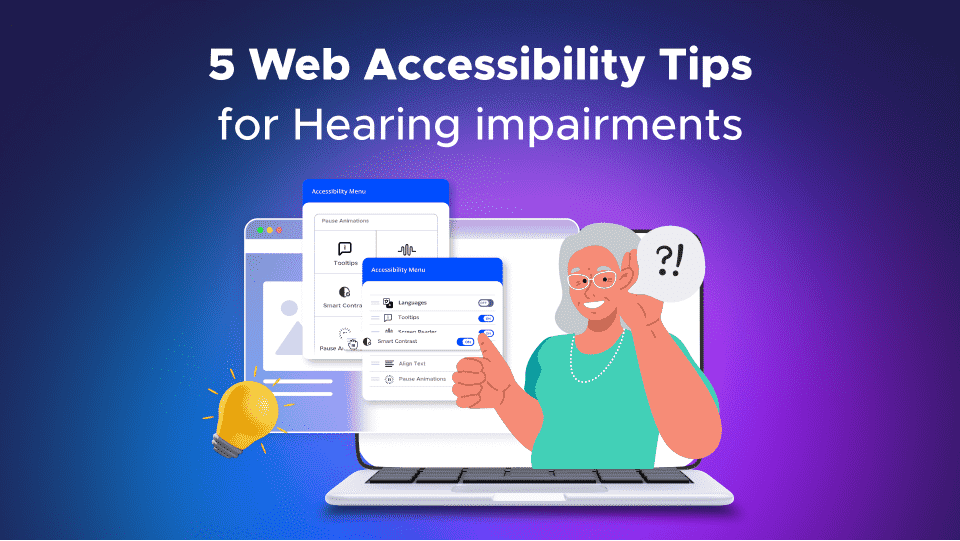5 Web Accessibility Tips for Hearing Disabilities

Even though over one billion people worldwide have hearing impairments, these conditions are still largely misunderstood. For example, misconceptions about the various levels and types of hearing impairment are widespread. In any case, it’s critical to have a website accessible to those with sensory hearing loss and all other disabilities.
Web inclusivity is an ethically sound approach for our fellow citizens, the law per ADA guidelines, and an excellent way to enhance your business. Fortunately, this article helps shed light on auditory impairments and essential facts, tips, and best practices for digitally accommodating this crucial demographic.
Hearing Disabilities & Accessibility: What You Need to Know
Hearing Impairments Have Different Levels of Severity
Everyone experiences hearing disabilities differently, depending on the severity of their condition. Here’s how some of the numbers break down:
- 50 million people in the U.S. have tinnitus
- Approximately 1 million Americans are functionally deaf
- Nearly 40 million American adults have some hearing challenges
- About 2% of adults aged 45 to 54 have disabling hearing loss
- 8.5% of adults aged 55 to 64 have hearing issues
- Nearly 25% of those aged 65 to 74 have disabling hearing loss
- 50% of those who are 75 and older suffer disabling hearing loss
Since each hearing loss disability impacts people differently, you should apply multiple strategies to increase your website accessibility. From a revenue standpoint, why would you want to exclude a vast user base when assistive tech for the hearing impaired is readily available? The most powerful and cost-effective way to achieve digital accessibility is by partnering with a third-party provider that offers AI technology.
There are Numerous Kinds of Hearing Difficulties
Hearing impairments also come in many different forms. See several examples below.
- Auditory processing disorders: these conditions stop the brain from accurately converting sound into information.
- Sensorineural hearing loss: this condition occurs with degeneration to the inner ear, cochlea, or auditory nerve.
- Tinnitus: old age and loud noise typically lead to this reverberating sound in the ears.
- Conductive hearing loss: this condition is deterioration that stops sound from entering the inner ear.
Hearing Impairments are Most Common Among the Elderly
Most people who suffer from hearing loss are in older demographics. For instance, a third of people aged 65-74, and nearly 50% of people 75 and older, suffer from a hearing impairment disability.
If your target audience is primarily older, being accessible to the hard of hearing is imperative. However, it would help if you also considered that accommodating deaf and hard of hearing people may parallel the need to include other disorders like vision and cognitive-related impairments.
Hearing Loss Also Impacts Children
Although the stats skew primarily toward people of advanced age, children aren’t immune to various levels of hearing impairment. A striking 15% of people aged 6-19 years suffer substantial hearing issues in one or more ears. Moreover, approximately 25-40% of kids who lose hearing capacity miss up to 40% of open discourse in a learning environment. These stats are especially relevant if you’re in the education sector but are still crucial regardless of your business model. After all, these kids are a substantial part of your future user base.
10 Web Accessibility Tips for Hearing Impairments
1. Offer transcripts of all audio files (e.g., videos and podcasts) from the same page on which they reside.
2. Always offer sign language for videos, using a sign language expert, by providing a recording, or through selective video edits.
3. Ensure your content is easy to comprehend for people with hereditary hearing and language impairments or second-language challenges.
4. Provide video captions and subtitles for all videos, preferably using reliable AI technology that offers manual, hands-on options for your dev team.
5. Use subtitles and transcripts to express who narrates all videos.
6. Minimize or eliminate unnecessary background noise, so foreground noise is loud and clear.
7. Provide recommended decibel levels for all audio elements. Government agencies advocate levels below 70 dBA for all users.
8. Offer visible cues as alternatives to audio announcements and alerts.
9. Provide volume functionality, including muting capabilities, as each user will have different requirements for a clear but comfortable listening experience.
10. Make sure users can contact you through numerous communication channels, including phone, email, and live chat options.
The UserWay Widget Can Help
UserWay’s AI solution helps increase your website’s accessibility to people with all disabilities, including those with hearing impairments. This easy-to-implement technology enables you to accommodate all of your fellow citizens, safeguards you from possible legal action, and helps elevate your online sales.
Common FAQs
Do All People with Hearing Impairments Use Hearing Aids?
The answer is no. While the National Institute on Deafness estimates that nearly 30 million Americans need hearing aids, people are often reluctant to use them. On average, people wait up to seven years to get medical help for hearing loss, including the use of hearing aids. That’s why it’s critical to make your site accessible to people with all levels of hearing disorder—including those with severe hearing loss and people who don’t recognize that their hearing has diminished with age.
What Laws Apply to Those with Hearing Disabilities?
Unfortunately, ADA legislation doesn’t specifically address web accessibility. However, it’s generally accepted and legally understood that the ADA requires accommodating people with all disabilities. The increasing number of lawsuits against all-sized companies for websites failing to comply confirms this. For example, the FCC mandates that all televised shows with closed captions must include them in corresponding online versions.
Does Everyone with a Hearing Disability use Sign Language?
As we’ve pointed out, there are multiple levels of hearing loss. So, not all people who suffer from these conditions use sign language. However, that doesn’t mean you should exclude sign language options from your website. Just remember that it doesn’t accommodate all of the various hearing-related impairments. That’s why you should take a comprehensive approach to assistive technology.




Share